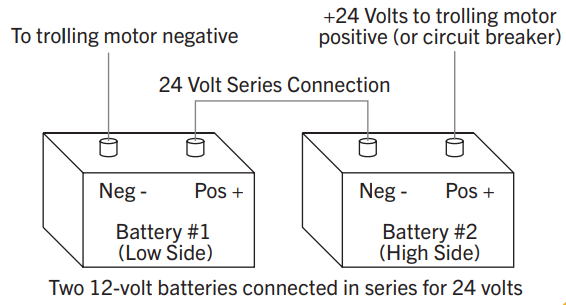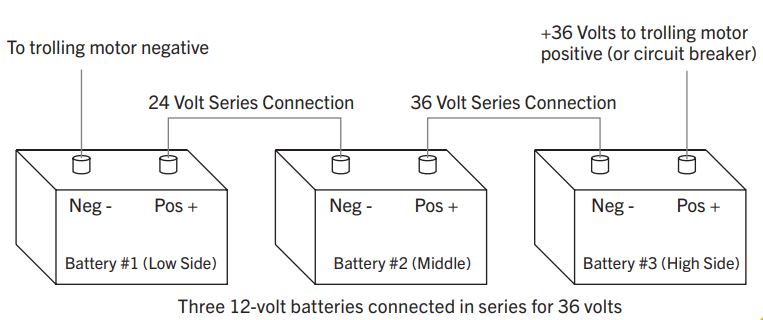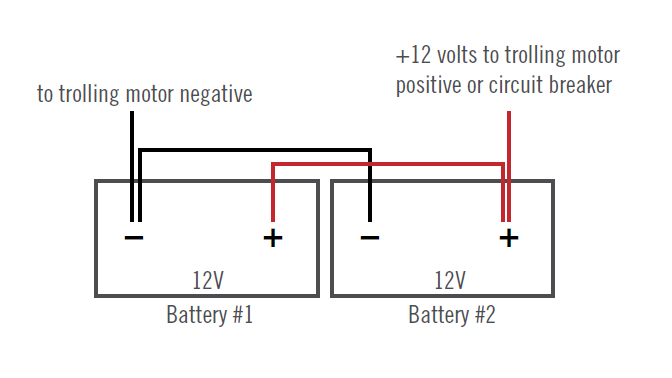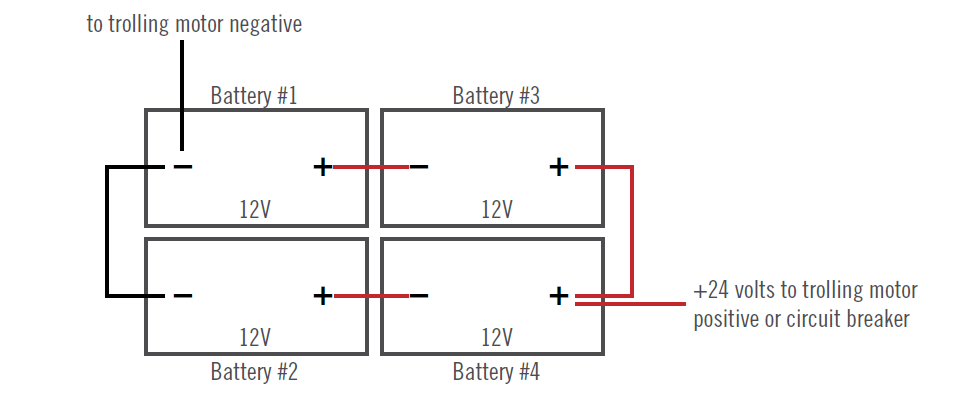
TROLLING MOTOR WIRING AND BATTERY GUIDE
BOAT RIGGING PRODUCT INSTALLATION
BOAT RIGGING & PRODUCT INSTALLATION
For safety and compliance reasons, we recommend that you follow American Boat and Yacht Council (ABYC) standards when rigging your boat. Altering boat wiring should be completed by a qualified marine technician. The following specifications are for general guidelines only:
CAUTION: These guidelines apply to general rigging to support your Minn Kota motor. Powering multiple motors or additional electrical devices from the same power circuit may impact the recommended conductor gauge and circuit breaker size. If you are using wire longer than that provided with your unit, follow the conductor gauge and circuit breaker sizing table below. If your wire extension length is more than 25 feet, we recommend that you contact a qualified marine technician.
CAUTION: An over-current protection device (circuit breaker or fuse) must be used. Coast Guard requirements dictate that each ungrounded current-carrying conductor must be protected by a manually reset, trip-free circuit breaker or fuse. The type (voltage and current rating) of the fuse or circuit breaker must be sized accordingly to the trolling motor used. The table below gives recommended guidelines for circuit breaker sizing.
CONDUCTOR GAUGE AND CIRCUIT BREAKER SIZING TABLE
This conductor and circuit breaker sizing table are only valid for the following assumptions:
- No more than 2 conductors are bundled together inside of a sheath or conduit outside of engine spaces.
- Each conductor has 105° C temp-rated insulation.
- No more than 3% voltage drop allowed at full motor power based on published product power requirements
*The 30lb thrust motor has been optimized to perform as a portable trolling motor. We therefore do not recommend altering the wire length as it can adversely affect its performance.
| MOTOR THRUST/MODEL | MAX AMP DRAW | CIRCUIT BREAKER | WIRE EXTENSION LENGTH | ||||
|---|---|---|---|---|---|---|---|
| 5 FT | 10 FT | 15 FT | 20 FT | 25 FT | |||
| 30 lb. | 30 | 30 Amp @ 12 VDC | DO NOT EXTEND* | DO NOT EXTEND* | DO NOT EXTEND* | DO NOT EXTEND* | DO NOT EXTEND* |
| 40 lb., 45 lb. | 42 | 50 Amp @ 12 VDC | 8 AWG | 6 AWG | 4 AWG | 2 AWG | 2 AWG |
| 50 lb., 55 lb. | 50 | 60 Amp @ 12 VDC | 8 AWG | 4 AWG | 2 AWG | 2 AWG | 1 AWG |
| 70 lb. | 42 | 50 Amp @ 24 VDC | 8 AWG | 8 AWG | 6 AWG | 6 AWG | 4 AWG |
| 80 lb. | 56 | 60 Amp @ 24 VDC | 8 AWG | 6 AWG | 6 AWG | 4 AWG | 2 AWG |
| 101 lb. | 46 | 50 Amp @ 36 VDC | 8 AWG | 8 AWG | 8 AWG | 8 AWG | 8 AWG |
| 112 lb. | 52 | 60 Amp @ 36 VDC | 8 AWG | 8 AWG | 8 AWG | 6 AWG | 4 AWG |
| Engine Mount 101 | 50 | 50 Amp @ 36 VDC | 8 AWG | 8 AWG | 8 AWG | 6 AWG | 6 AWG |
| Engine Mount 160 | 116 | See Product Manual | 6 AWG | 4 AWG | 2 AWG | 1 AWG | 1/0 AWG |
| E-Drive | 40 | 50 Amp @ 48 VDC | 8 AWG | 8 AWG | 8 AWG | 8 AWG | 8 AWG |
| Talon Shallow Water Anchor | 30 | 50 Amp @ 12 VDC | 8 AWG | 6 AWG | 4 AWG | 4 AWG | 2 AWG |
| Raptor Shallow Water Anchor | 70 | 50 Amp @ 12 VDC | 10 AWG | 8 AWG | 6 AWG | 4 AWG | 4 AWG |
| QUEST 24V | 60 | 60 Amp @ 36 VDC | 6 AWG | 6 AWG | 4 AWG | 4 AWG | 2 AWG |
| QUEST 36V | 60 | 60 Amp @ 36 VDC | 6 AWG | 6 AWG | 6 AWG | 6 AWG | 4 AWG |
NOTICE: Wire Extension Length refers to the distance from the batteries to the trolling motor leads. Consult website for available thrust options. Maximum Amp Draw values only occur intermittently during select conditions and should not be used as continuous amp load ratings.
Reference United States Code of Federal Regulations: 33 CFR 183 – Boats and Associated Equipment ABYC E-11: AC and DC Electrical Systems on Boats
SELECTING THE CORRECT BATTERY
What type of battery do I need to run my Minn Kota Trolling Motor?
A Minn Kota trolling motor will operate with any lead acid, deep cycle marine 12-volt battery/batteries. For best results, use a deep cycle, marine battery with at least a 110-ampere hour rating.
| RUN-TIME | VOLTAGE | GROUP SIZE | AMP-HOUR |
|---|---|---|---|
| Good | 12 | 24 | 70-85 |
| Better | 12 | 27 | 85-110 |
| Best | 12 | 31 | 95-125 |
ADVICE REGARDING BATTERIES
- Never connect the (+) and the (-) terminals of the same battery together. Take care that no metal object can fall onto the battery and short the terminals. This would immediately lead to a short and extreme fire danger.
- It is highly recommended that a circuit breaker or fuse be used when installing a trolling motor. Refer to the Minn Kota “Conductor Gauge and Circuit Breaker Sizing Table”. For motors requiring a 60-amp breaker, the Minn Kota MKR-27 60-amp circuit breaker is recommended.
- Batteries should be stored and maintained at full charge. Failure to recharge lead-acid batteries (within 12-24 hours) is the leading cause of premature battery failure. Minn Kota offers a wide selection of chargers to fit your needs and application.
- If using a crank battery to start a gasoline outboard, we recommend that you use separate deep cycle marine battery/batteries for your Minn Kota trolling motor.
CAUTION:
- For safety reasons do not switch the motor on until the propeller is in the water. If installing a lead wire plug, observe proper polarity and follow instructions in your boat owner’s manual.
- For safety reasons, disconnect the motor from the battery or batteries when the motor is not in use or while the battery/batteries are being charged.
- Improper wiring of 24/36/48-volt systems could cause battery explosion!
- Keep all battery post connections tight to the battery terminals.
- Install battery in a ventilated compartment.
HOW TO CONNECT BATTERIES IN A SERIES
24 Volt Systems (2 Batteries)
Two 12-volt batteries are required. The batteries must be wired in
series, only as directed in the wiring diagram, to provide 24 volts.
- Make sure that the motor is switched off (speed selector on “0”).
- Connect a connector cable to the positive ( + ) terminal of
battery 1 and to the negative ( – ) terminal of battery 2. - Connect positive ( + ) red motor lead to positive ( + ) terminal
on battery 2. - Connect negative ( – ) black motor lead to negative ( – ) terminal
of battery 1.

36 Volt Systems (3 Batteries)
Three 12-volt batteries are required. The batteries must be wired in series, only as directed in the wiring diagram, to provide 36 volts.
- Make sure that the motor is switched off (speed selector on “0”).
- Connect a connector cable to the positive ( + ) terminal of battery 1 and to the negative ( – ) terminal of battery 2 and another connector cable from the positive ( + ) terminal of battery 2 to the negative ( – ) terminal of battery of battery 3.
- Connect positive ( + ) red motor lead to positive ( + ) terminal on battery 3.
- Connect negative ( – ) black motor lead to negative ( – ) terminal of battery 1

48 Volt Systems (4 Batteries)
Four 12-volt deep cycle batteries are required. Batteries in the system must be the same manufacture, type, size, and age.
- Make sure that the trolling motor is disconnected.
- Wire in series only as directed in wiring diagram, to provide 48 volts.
- Connect a connector cable to the positive (+) terminal of battery 1 and to the negative (-) terminal of battery 2. The jumper wire used should be one size larger than the Trolling Motor lead wire.
- Connect a connector cable to the positive (+) terminal of battery 2 and to the negative (-) terminal of battery 3. The jumper wire used should be one size larger than the Trolling Motor lead wire.
- Connect a connector cable to the positive (+) terminal of battery 3 and to the negative (-) terminal of battery 4. The jumper wire used should be one size larger than the Trolling Motor lead wire.
- Connect positive (+) red lead (from motor) to positive (+) terminal on battery 4.
- Connect negative (-) black lead (from motor) to negative (-) terminal of battery 1.

HOW TO CONNECT BATTERIES IN PARALLEL
12 Volt System (2 Batteries)
- Two 12-volt deep cycle batteries are required. Batteries in the system must be the same manufacture, type, size, and age.
- Make sure that the trolling motor is disconnected.
- Wire in parallel only as directed in wiring diagram, to provide 12-volt system with increased amp hour capacity.
- Connect a connector cable to the positive (+) terminal of battery 1 and to the positive (+) terminal of battery 2.
- Connect a connector cable to the negative (-) terminal of battery 1 and to the negative (-) terminal of battery 2.
- Connect positive (+) red lead (from motor) to positive (+) terminal on battery 2.
- Connect negative (-) black lead (from motor) to negative (-) terminal of battery 1.

24 Volt System (4 Batteries)
- Four 12-volt deep cycle batteries are required. Batteries in the system must be the same manufacture, type, size, and age.
- Make sure that the trolling motor is disconnected.
- Wire in parallel only as directed in wiring diagram, to provide 12-volt system with increased amp hour capacity.
- Connect a connector cable to the positive (+) terminal of battery 3 and to the positive (+) terminal of battery 4.
- Connect a connector cable to the negative (-) terminal of battery 1 and to the negative (-) terminal of battery 2.
- Connect a connector cable to the positive (+) terminal of battery 1 and to the negative (-) terminal of battery 3.
- Connect a connector cable to the positive (+) terminal of battery 2 and to the negative (-) terminal of battery 4.
- Connect positive (+) red lead (from motor) to positive (+) terminal on battery 4.
- Connect negative (-) black lead (from motor) to negative (-) terminal of battery 4.
